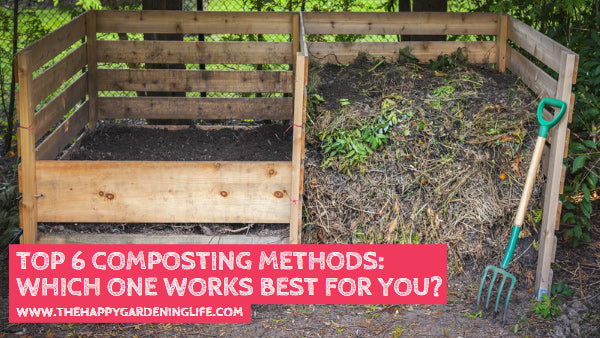
Top 6 Composting Methods: Which One Works Best for You?
Share
 Composting is a key component of organic gardening. It uses all-natural materials like kitchen scraps, yard trimmings and newspapers so it’s not only economical but cost-saving as well.
Composting is a key component of organic gardening. It uses all-natural materials like kitchen scraps, yard trimmings and newspapers so it’s not only economical but cost-saving as well.
It’s also incredibly easy to make, but the greatest thing about compost is that it provides the best possible nutrients to your garden plants.
Now there are several ways to create good compost. One of those is called vermicomposting, which uses beneficial worms to break down the organic matter and quickly turn it into compost.
The next type is using closed bins. The bins are often made from recycled plastic and they come with lids to cover the compost.
This closed bin method works for cold composting and is ideal for people who live in both urban and suburban areas.
Another type is called pit composting, which is perfect for those who want to hide their decomposing matter. Here, you’ll need to dig up your soil to contain your organic matter and wait until it gradually breaks down into pieces overtime.
Those are some of the top composting methods used by home gardeners around the world. Check out this article to know which of the techniques is most suitable for you. Don’t forget to share your gardening tips and tricks as well by leaving a comment below!
Which of These Composting Methods is Suitable for You?
Closed Bin Keep Compost Neat and Clean
Closed bins are usually made from recycled plastic and can come in different shapes—from square to cylindrical. All options have a lid to cover the container. These bins are a good cold-composting choice for urban and suburban locations. They do, however, present some difficulties. They cannot be used for hot composting, for example, because the closed bin makes it difficult to maintain the required temperature. The containers also hold a limited volume of material.
Pit Composting
This method is effective for those who want their decomposing organic matter to be completely out of sight. The trench is also a good place to stick those weedy plants you have pulled up. If buried deep enough, the weed seeds will not see the light of day, so they won’t resprout.
Open Bins Make Hot Composting Simple
Open bins are an excellent way to do hot or cold composting. These types of bins typically use either wire fencing or wood to create a neat, structured area to stockpile your organic matter. The openness of the bin(s) allows for easy turning and harvesting of materials and for air to enter and circulate, speeding up decomposition. Open bins also keep compost materials tidy and partially hidden from view, making the area less of an eyesore for you and your neighbors.
Tumblers Ease the Burden of Turning
Tumblers are better used for cold composting; they are not reliable method for hot composting because it is difficult to reach and maintain the necessary temperature for killing weed seeds and disease pathogens within the volume available. Because there is no contact with the ground, you should add a shovelful of soil to the mix to increase the diversity of microbial life, which aids in breaking down organic matter.
Piling Produces Big Rewards with Zero Cost
Piling is another great option for hot and cold composting. It is, however, less desirable in small urban and suburban locations, unless you are able to camouflage the materials from view with a skillful garden design. Piles work in larger landscapes, but do not build them higher than 5 feet tall: They might collapse on themselves and, thereby, lose air pockets that help speed up the composting process.
Vermicomposting Makes the Most of Small Spaces
Vermicomposting uses worms to do the work. You just need to bury your food waste under moistened bedding material. The bedding is made from shredded paper, dead leaves, or straw. It is an excellent option for those living in apartments or other small spaces.
Red wigglers are best suited for home composting. They are comfortable living in a box filled with bedding material, and will reproduce and happily eat your food waste.
Article Source: finegardening.com
